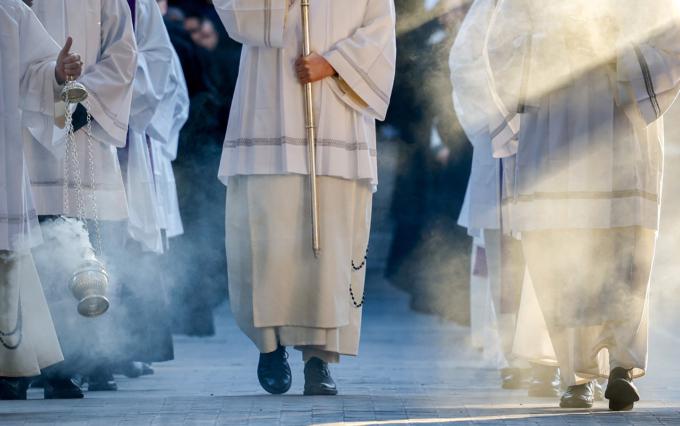
Faith
Servers are also part of a wider team of ministers at each liturgy. So, they must be comfortable working with others, even of different ages and abilities.

O'Grady
More than most teams of liturgical ministers, altar servers come in all sizes and characteristics. Short and tall, narrow and wide, neat as a pin, others askew, some well past retirement age, many six or seven decades away from that. And, of course, following much discussion (some heated), male and female. All of them come to their ministry wanting to help us celebrate the sacred mysteries.
Servers have been at liturgies, especially Holy Mass, from earliest times. Their tasks have evolved and changed, and their names have, as well. Their duties have sometimes shifted back and forth between and among other ministries, and as many readers recall, they were previously all male. The simple explanation for that is that they took the place of the clergy, and especially of those who were preparing for the priesthood. And since they were all male, it seemed logical for those taking their place also to be male.
With the expansion of the servers' ministry to many others, there probably is not any reason why there would not be at least one server at any parish Mass -- Sunday or otherwise. The opening of the ministry also means that occasional parish events, e.g. funerals, and, in some places, weddings, can also have servers.
Whatever the age, sex, size, or hair color of the server, preparation and training, both initial and ongoing, are very important. The server needs to know what is expected at the liturgy. There are admittedly lots of details in the celebration of any of our liturgies. And these can vary from place to place, and from occasion to occasion.
Very important, especially for younger servers, is instilling a sense of confidence in them during their training. Those who train them must convince them that they can do the job. In addition to their behind-the-scenes training, an excellent way to help new servers is to assign them as "observers" with the veterans. It's always impressive to see older servers readily help younger servers learn.
For more complex ceremonies, for example, the Holy Week liturgies, it is a very good idea to have a rehearsal for each liturgy.
Servers are also part of a wider team of ministers at each liturgy. So, they must be comfortable working with others, even of different ages and abilities.
Servers must be familiar with lots of details. They must know about the various books used at Mass, the vesture of ministers (including their own), the vessels that are used -- chalice, ciboria, patens.
They are responsible for lighting and extinguishing candles, for managing the use of incense, and knowing where things are in case something necessary has been inadvertently omitted during preparations for Mass.
They should also understand expectations, such as arrival time before their assignment, when to sit, stand, or kneel, and what to do after the liturgy is finished.
During their training, they will come to know that they are "being watched," and that is in two ways. They might serve as the "cue" for others in the assembly, especially visitors, what they should be doing -- sitting, standing, kneeling -- and, yes, responding, verbally or musically. They also need to be aware that there may be those who are "more critical" and looking for "any misstep." Dads and Moms can be great allies for both younger novice servers and priests, as they will often find room for improvement. And they are usually the best ones to offer advice in an appropriate place and at a proper time.
Some parishes have found success in forming teams of servers. These groups of individuals may be of similar age, live as neighbors in the parish, or go to the same school -- Catholic or other. This makes looking for substitutes or swapping assignments a bit easier.
Parishioners very much appreciate the ministry of servers. This is especially true when they see teenagers and youth serving. It is not as difficult to accomplish this in a parish. Usually, on the cusp of high school, they want to "retire." A good response is, "Why? You and your family are here at Mass. You know what you're doing as a server. And you'll be a good example to the younger servers." Most of the time, that works.
There are many resources for servers and those who train them, and they can vary according to the age group. Here are a few suggestions:
For all age groups and especially for trainers: "Guide for Servers, Second Edition" (2021, Liturgy Training Publications).
For younger servers: "Serve God with Gladness: A Manual for Servers" by David Philippart (2007, Liturgy Training Publications).
A comprehensive and detailed resource: "Ceremonies Explained for Servers: A Manual for Altar Servers, Acolytes, Sacristans, and Masters of Ceremonies" by Bishop Peter J. Elliott (2019, Ignatius Press).
And several diocesan guidelines:
Davenport: DavenportDiocese.org/liturgy-policies
Los Angeles: LACatholics.org/altar-servers (Available in English and Spanish)
Owensboro: OwensboroDiocese.org/wp-content/uploads/Altar_Servers.pdf.
Comments
Comments Policy
Recent articles in the Faith & Family section
-
Praise the Lord -- and forget the ammunitionJaymie Stuart Wolfe
-
ServersFather Robert M. O'Grady
-
Join the Cardinal Cushing Club and See the World!Maureen Crowley Heil
-
To belong to ChristScott Hahn
-
Are fairies and leprechauns demonic?Jenna Marie Cooper


















